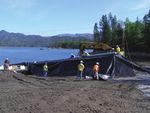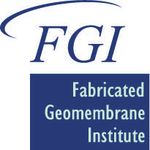Temperature Curtain Improves Salmon Habitat
←
→
Page content transcription
If your browser does not render page correctly, please read the page content below
Presented by the Fabricated Geomembrane Institute
Photo: Bob Gee
Temperature Curtain Improves Salmon Habitat
By Bob Gee, Bureau of Reclamation, Greg Morris, Bureau of Reclamation & Stanford Slifer, Watersaver CO.
A temperature curtain reaching depths of 100 feet in rafts and roofing. “The holes were caused by
recently replaced curtains originally installed in the curtain rubbing against chains linking buoys
both the upper and lower reaches of Whiskeytown holding the top of the curtain to anchors on the
Reservoir in the early 1990’s. Located at the lake bottom,” Gee said.
Whiskeytown Reservoir approximately 10 miles
west of the city of Redding, in Shasta County Cali- "It just had deteriorated," said Brian Person, man-
fornia, the purpose of the replacement curtain is ager for the bureau's Northern California Area Of-
to lower the temperature of the Sacramento River fice at Shasta Dam. "So it was time for a replace-
for fish spawning which would restore the Chinook ment." The old curtain was removed in the fall of
salmon runs to this part of the Sacramento River. 2010 and the new curtain was installed and made
operational in June 2011.
Due to the deterioration of the temperature cur-
tain at the mouth of the Spring Creek Power Erick Ammon, Inc. was chosen by the California
Plant, plans were made for a complete replace- Bureau of Reclamation to do the job. Nestled
ment. According to Bob Gee, a mechanical engi- among the hills and valleys of California’s Klamath
neer for the bureau's Northern California Area Of- Mountains, the Whiskeytown Lake curtain serves
fice, the old curtain, installed in 1993 had a lot of as a barrier to keep warm water from the Carr
holes in it. The original temperature curtain was Powerhouse from mixing with cold water that is
made of Hypalon®, a synthetic rubber also used necessary for salmon reproduction. This allowsTemperature Curtain Improves Salmon Habitat
Photo: Greg Morris
Photo 1: Map of the Whiskeytown project area
the cold water to go into a tunnel leading to the installed in wastewater lagoons, industrial waste
Sacramento River. (see Photo 1) This is achieved ponds and fish hatcheries. It took approximately
by creating about a 30-foot-gap between the bot- 260,000 square feet of 60mil (nominal) rPP black
tom of the curtain and the bottom of the lake geomembrane to complete the job.
through which the cold water flows.
According to Gee, finding an open area ashore
Bureau engineers redesigned this curtain using a large enough for assembly of the curtain was a
60-mil-reinforced polypropylene geomembrane challenge. “Working with the National Park Ser-
(rPP) manufactured by Carlisle Syntec. It was se- vice, we were able to utilize a parking lot at a
lected in part because the Bureau of Reclamation beach prior to the summer recreation season,”
desired to try a different material. Reinforced says Gee. “It measures 2,400 feet in length and
polypropylene geomembranes are most commonly reaches depths of approximately 100 feet . The
Photo: Bob Gee
Photo: Bob Gee
Photo 2: Assembly of the curtain on the shoreline Photo 3: Shoreline fabrication
2Temperature Curtain Improves Salmon Habitat
ternational Lining Technologies (Reno, NV) con-
quered the challenges. Coordinating specific pan-
els and various sizes in the proper order per pro-
ject drawings proved to be one of the greater
challenges during installation. Topography of the
lake bottom was little known. Divers were sent
down to accurately measure the depths of the
lake to ensure each panel sizing matched the lake
Photo: Bob Gee
contours. Watersaver Company, Inc. (Denver, CO)
then had the difficult task of custom fabricating
panels to the contour of the lake. Nearly half of
the panels needed to be hemmed on a diagonal.
An onsite field inspector was provided by Recla-
Photo 4: Crane setting a float onto the frame. mation’s Mid Pacific Construction Office to ensure
quality fabrication and installation. See Diagram 1.
curtain was hot spliced on the reservoir shoreline Another challenge was presented by the onsite
and assembled as one continuous sheet of poly- welding process which used a conveyor system in
propylene.” order to make necessary fusion welds per material
specifications. The job also required the reuse of
Installation procedures were truly unique and In- the existing upper boom floating tanks or replace-
Diagram 1: Take-off for the temperature curtain.
3Temperature Curtain Improves Salmon Habitat
Photo: Stanford Slifer
Photo: Bob Gee
Photo 5: Eighty pound metal weights (foreground) Photo 6: Geomembrane curtain was clamped in the
used to secure the curtain. metal floats before being deployed.
Photo: Stanford Slifer
Photo: Bob Gee
Photo 7: The floats and the curtain were deployed Photo 8: Metal floats in place and curtain ready to be
using a conveyor system. anchored to the river bottom by 800 pound weights.
ment with new floating tanks, as well as the reuse contours while a gap at the curtains bottom allows
of existing components including shore anchors, colder water to pass under the curtain and into
lake anchors and associated chain, cable and the power plant intakes.
hardware, and surface stabilizing tanks which
were all to remain in place. The job required that Discharges from Spring Creek Power Plant are
the curtain conform to the contours of the reser- eventually blended into the Sacramento River be-
voir from shoreline to shoreline, floating vertically. low Keswick Dam.
The curtain was attached to 20-foot-long metal The $3-million dollar project completed a month
floats and anchored by 800 pound weights. It ahead of schedule in June 2011. According to
was designed to conform to the reservoir bottom Gee, the new 2,400-foot-long curtain should last
4Temperature Curtain Improves Salmon Habitat
Photo: Bob Gee
Photo 9: The conveyor system for pulling the curtain out into the river during the installation process is
visible in this picture.
at least 15 years. Data is being archived to deter- Authors:
mine the temperature curtain performance. To Bob Gee, Bureau of Reclamation, Mechanical Engineer
date, the curtain is performing as designed. It is Greg Morris, Bureau of Reclamation, Chief Engineer
anticipated to achieve a 2 to 4 degree drop in wa-
Stanford Slifer, Watersaver Co. President
ter temperature.
This curtain will allow the salmon and the power
plant to co-exist in the same river. As more de-
mands are placed upon our natural resources,
more innovative solutions such as this will need to
be implemented.
5You can also read

























































